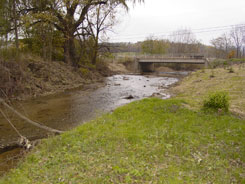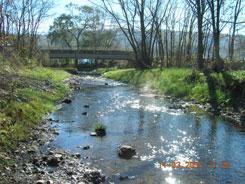Projects:
Crooked Creek,
Walker Township, Huntingdon County
In 1961, the Pennsylvania Department of Transportation (PennDOT) relocated a portion of Crooked Creek as part of a bridge replacement project. In the process, the stream channel in the vicinity of the bridge was also widened to increase the hydraulic flood flow capacity. This over-wide channel reach caused sediment and gravel to accumulate in the stream near the bridge. This condition not only created a chronic maintenance problem for PennDOT, but the excess sediment placed stress on the aquatic community and limited the reproductive capacity of fish populations. The U.S. Fish and Wildlife Service, PennDOT, and the Wildlife for Everyone Foundation collaborated to develop and implement a stream restoration plan. The goal of the restoration project was to restore the stream channel to more natural dimensions, thereby assisting in the downstream movement of sediment, and installing structures that would minimize bank erosion and enhance the aquatic habitat. PennDOT provided funding for the project, U.S. Fish and Wildlife Service provided planning, design, and construction expertise, and the Wildlife for Everyone Foundation provided financial management services.
The project is located on Crooked Creek, near McConnellstown, PA, on SR 3037. A detailed stream channel survey was conducted in 2004; this, in conjunction with a reference reach model, was used to develop the restoration plan which was successfully implemented in the summer of 2007. Over 900 feet of stream channel were restored. This restoration consisted of: the construction of a bankfull bench on both sides of the stream in the vicinity of the bridge to narrow the channel to its proper width; the construction of eight sets of paired rock vanes to stabilize the stream banks by directing the high-velocity flow to the center of the channel; and the installation of a mudsill, which will stabilize the stream bank, and also provide overhead cover and therefore valuable fish habitat. This project has multiple benefits: decreasing sediment accumulation around the bridge, thereby minimizing bridge maintenance for PennDOT; stabilizing the banks, thus significantly reducing erosion and sediment input; and improving the aquatic habitat by providing a more natural and healthy stream channel. The reduction of fine sediment in the stream makes it more conducive to fish reproduction; the rock vanes and mudsill provide areas of habitat for many aquatic species. Significant improvement is anticipated in regards to the ecological functions of this portion of the stream.

Before: The over-widened channel spanned the entire width of the bridge, casuing the sediment to drop out due to a decrease in flow velocity. (looking upstream)

After: The channel was brought into proper dimension by buildinng out the banks at floodplain level. This results in better sediment transport. (looking downstream)
